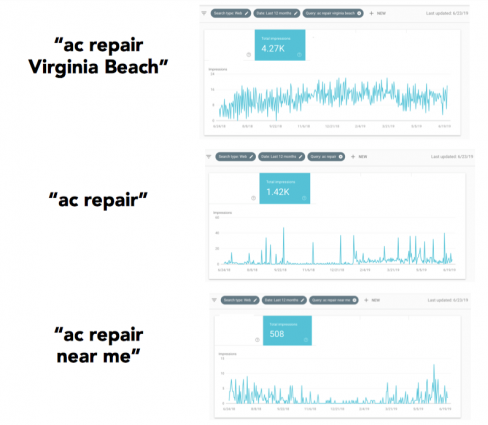
If you perform a Google search for a local home services provider, today’s results are pretty well stacked. You can expect to see two to four paid search ads, a three-pack of Google Maps results (some of which may also be sponsored or paid ads), and anywhere from six to 10 organic results. Not to mention – if you’re searching for a service which qualifies for Local Service Ads – the whole SERP will likely be topped with a row of one to three LSA’s and an option to view more. That’s a whole lot of real estate devoted to local search results, and a whole lot of competition for customers in your service area.
The challenges facing local HVAC, home performance, and solar companies when it comes to establishing and improving local SEO rank and visibility are obvious, especially when their primary office or place of business is physically located in a city or town where competitors are densely packed. Adding to the challenge is the reality that most home service, better building, and clean energy contractors and companies have service areas well beyond the town or city in which they’re physically located. This only increases the amount of competition and complexity of the methods and strategies you need to employ to combat it.
We have long known how much emphasis Google places on the quality and verification of your GMB profile (which has strict rules about how many and what types of physical addresses can be associated with it). We also know that Google prioritizes results for business whose primary location is physically closer to where the person is searching from and that Google knows this with ever increasing precision. . So, what’s the best way to gain visibility in SERP for towns or cities outside of a primary business address?
In other words: How do we capture customers in areas beyond our core location?
Understanding How Google Deals with “Local Search Intent”
To begin, it’s important to understand how Google identifies and manages what is known as “searcher intent” – more specifically, what are the patterns, terms, and phrases which indicate to Google that the searcher is looking for local information, services or products (as opposed to general, non-location specific content)?
There are three main types of searches that are likely to trigger some form of local result in SERP. The searcher may use all three of these or any combination during a given search, and depending on the type of search performed, Google may interpret the intent of the search slightly differently.
-
Non-Geo Modified: A simple keyword search that contains just the term or phrase a user is looking for without anything additional that indicates the user cares where the end results are located. For example: “solar installer” or “insulation” – both searches for a product or service, but with no additional modifiers, like a city or town name, that might imply the searcher wants results for that service or product in a specific place. Of course, this is NOT to say that non-geo modified searches WON’T trigger local results - but we’ll come back to that!
-
Geo-Modified: A keyword search where the user manually includes a location specific term or name as part of the search. For example: “solar installer in Portland, Maine” or “Portland insulation provider.” Google considers “geo-modified” searches indicative of “explicit intent,” meaning the SERP is likely to be heavily weighted toward local results which are optimized for the specific location searched (and less weighted toward the physical location of the searcher themselves.) The exception to that priority is when the searcher uses “near me” as the geo modifier instead of “in [city].” The inclusion of “near me” (or comparable terms) indicates to google the searcher is explicitly interested in results which are in close proximity to their physical location.
-
Geo-Location: This refers to when a searcher has “location services” options active on whatever device they’re using to search – in other words, data related to GPS, WiFi nodes, cell towers, or IP addresses is being shared by the searcher’s device, allowing the search provider to deliver results tailored to the physical location of the searcher themselves. The SERP is likely to be more weighted toward proximity in this scenario, especially if no additional, manual geo-modifier is used as a part of the search.
It’s worth noting that, unless a user has purposefully configured privacy and location services settings on their devices to prevent data about their physical location from being shared with apps or software, even non-geo modified searches are likely to still qualify as “geo-location” searches which Google often will interpret as “implicit intent.”
The key takeaway being that, now-a-days, practically every search is a “local search.”
The Proximity Challenge for Service Area Businesses
If we accept the idea that most searches now are essentially local searches, and understand the significant bias Google applies toward searcher proximity, it’s clear that the physical location of your business matters when it comes to SERP rank and visibility… a lot. If you only have one business address, though – but, like many service oriented businesses, you serve customers in areas well beyond that core location, it can be challenging to gain SERP traction in those further away areas. When the searcher is providing data on their physical location, or is geo-modifying their searches to include city or town names, Google is likely to interpret that as explicit or implicit local search intent, and serve up results that are tailored to that intent.
So, even if the competition in those neighboring cities and towns doesn’t have as strong a collection of reviews, or as optimized of a web presence, or as much of a marketing budget as you do, it’s still a challenge to overcome them when Google prioritizes proximity above all else.
Furthermore, recent trends in search behavior (according to Google, as well as a recent whitepaper issued by Moz) show a steep decline in the use of geo-modifiers that specifically indicate a preference for proximity, like “near me” or “closest.” Much more frequently, people are searching for products and services using “in [city]” geo-modifiers or no modifier at all, and simply relying on geo-location to translate their local search intent to Google for them.

In our example - Google Trends data shows that search volume for terms containing a specific city or town name geo-modifier was the highest, over the last 12 months. Searches containing no geo-modifier (so, presumably relying on geo-location to generate local results), had the second highest search volume, while searches containing “near me” were the least frequently searched, over the last 12 months.
The key takeaway here is, more often than not, searchers are manually specifying a city or town boundary when searching for local products or services. And, more often than not, Google is prioritizing business results that have a verified address physically located within that boundary over businesses who may serve that area but are not actually based there.
Tactics & Strategies for Overcoming Local Search Proximity Bias
So what can we do?
First, be sure to keep in mind all the basic “DON’T DO’s” – tricks and work-arounds like geo-stuffing or creating fake addresses will only hurt you. Penalties for trying to fool Google can be severe, so keep everything above board and follow all SEO best practices and Google My Business rules and regulations.
Focus on reputable methods to overcome proximity bias and build momentum and visibility in local SERP. There are things you can do to move the needle, for example:
-
Buy your way into the Local Pack: Those three or four listings that usually display below the Google Map result often contain a paid search ad among them. Connect your verified Google My Business profile to your Google Ads account, and make use of Google’s “Location Extensions” feature to increase the chance that your PPC ad will display in the Local Pack among the organic results.
-
Onsite SEO: Meta Titles, Descriptions, & Headers: Metadata and structural elements in your on page HTML, like header or “H” tags, are strong indicators to Google as to what the content on your pages is about, and how important it is to the overall purpose of your website. Without geo-stuffing, incorporate city and town names alongside service and product keywords into these key places on your site pages wherever it makes sense and accurately describes the context of the page on which they’re embedded.
-
City Pages for Key Services & Locations: Place your services in the context of the areas in which you provide them. Create long form, comprehensive “city pages” as destination landing pages on your site for people searching for services in those specific areas. Focus content, imagery, and keywords around the specific location where you’re trying to improve visibility. Use local terminology, testimonials from local residents, embed a google map that shows the specific area you’re referring to, feature projects from that area, and tailor the entire experience around that one location.
-
Localized Content: Galleries, Case Studies, and Maps: Along the same lines as City Pages, incorporate other forms of content throughout your site that feature all the key locations for which you want to gain SERP visibility. Case studies, image galleries, embedded maps or videos that are dedicated to a specific city / town (outside your primary location) can be geo-tagged and published on city pages or their own unique landing pages and used as strong indicators to Google that you have a robust service offering in that specific geography.
Overcoming Google’s proximity bias is one of the most common challenges faced by service area businesses, and one that we – as digital marketers – are regularly navigating. The good news is, at the end of the day, Google does seem to prioritize content, information and even ads that they believe will best serve the searcher. (Are there other motivations at play? Of course. But we have to assume benevolent intent at least some of the time, right?) If you customize the content, and user experience on your website, and across your various online channels, to be more relevant and useful to the customer you’re trying to capture (and you support that effort with strategic paid advertising), Google will reward you.
You may never be the most visible or the highest ranked listing in those “far away” service areas, especially when proximity and strong competition are both working against you, but a solid content and digital marketing strategy will help you get much closer.